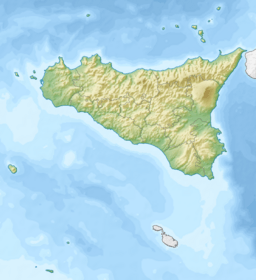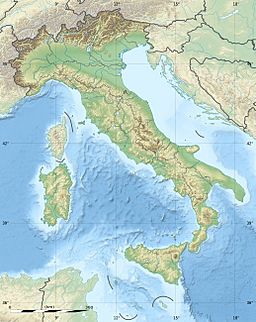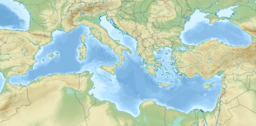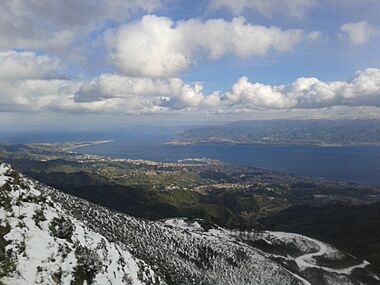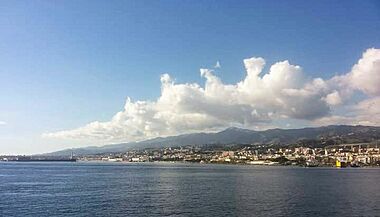Strait of Messina facts for kids
Quick facts for kids Strait of Messina |
|
|---|---|
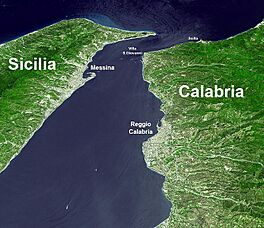
Satellite photo of the Strait of Messina with names. NASA image.
|
|
| Location | Tyrrhenian Sea–Ionian Sea |
| Coordinates | 38°14′45″N 15°37′57″E / 38.24583°N 15.63250°E |
| Type | Strait |
| Native name | |
| Basin countries | Italy |
| Min. width | 3.1 km (1.9 mi) |
| Settlements | Messina, Villa San Giovanni, Reggio Calabria, Scilla, Calabria |
The Strait of Messina (Italian: Stretto di Messina; Sicilian: Strittu di Missina) is a narrow stretch of water in southern Italy. It lies between the eastern tip of Sicily and the western tip of Calabria. This strait connects the Tyrrhenian Sea in the north with the Ionian Sea in the south. Both are parts of the larger Mediterranean Sea. At its narrowest point, the strait is about 3.1 kilometers (1.9 miles) wide. Near the city of Messina, it is about 5.1 kilometers (3.2 miles) wide. The deepest part of the strait is around 250 meters (820 feet) deep.
The Strait of Messina has strong ocean currents. These currents create a special home for many unique sea creatures. You might have heard of the Greek legend of Scylla and Charybdis. This legend is linked to a rock formation near Scilla, Calabria and a natural whirlpool in the strait. Sometimes, a cool optical illusion called Fata Morgana can be seen here. This happens when looking at Sicily from Calabria. The strait is also like a narrow hallway for many bird species. They use it during their yearly migrations.
In 1957, a large overhead power line was built across the strait. Its tall pylons were among the highest in the world. This power line has since been replaced by a submarine power cable. However, the old pylons are still there. They are now protected as historical monuments. On July 10, 2024, an athlete named Jaan Roose from Estonia crossed the Strait of Messina. He walked on a slackline stretched between the two famous pylons. He set a new world record for the longest slackline walk, covering 3,600 meters (about 2.2 miles).
Contents
Wildlife Wonders: Birds and Marine Life
Bird Migration: A Busy Highway in the Sky
The Strait of Messina is a very important place for migrating birds each year. Birds mainly cross the strait to fly to their breeding areas in northern Europe. Because the strait is so narrow, it acts like a "bottleneck." This means many birds pass through a small area. More than 300 different bird species have been seen here. It is a major spot in Europe for raptors, which are birds of prey. One spring, a record 35,000 raptors were counted!
Some of the most common birds seen are the European honey buzzard and the marsh harrier. Rarer birds like Bonelli's eagle and Egyptian vulture also pass through regularly. Along the coast, in the salt lakes, birds like the glossy ibis, flamingos, and black-winged stilt stop to rest. It is also a great place to see storks. The Monte Dinnammare mountain and other Peloritani mountains look over the strait. They offer a natural viewing spot for birdwatching.
Deep Sea Creatures and Ocean Journeys
The Strait of Messina has special water conditions. These conditions lead to a huge variety of sea life. Many unique species that live nowhere else can be found here. Deep-sea fish, like the Sloane's viperfish, are often found. Because of the strait's unusual currents, these fish sometimes get washed ashore at sunrise. The strait is also a key pathway for many fish species. They use it for their migrations across the Mediterranean Sea.
Connecting Shores: Ferries and Bridge Dreams
Crossing the Strait: Ferries and Hydrofoils

A ferry service connects the city of Messina on Sicily with the mainland. This service goes to Villa San Giovanni. Villa San Giovanni is a few kilometers north of the larger city of Reggio Calabria. These ferries carry cars and even train carriages. This allows mainline trains to travel between Palermo and Naples. There is also a faster hydrofoil service. This service connects Messina directly with Reggio Calabria.
The Big Bridge Idea: Connecting Sicily and Italy
For many years, people have talked about building a bridge across the Strait of Messina. This idea has been discussed for decades. In 2006, a plan to build the bridge was stopped. However, in 2009, the government announced that the bridge plans were back on. They promised a large amount of money for the project.
The proposed Strait of Messina Bridge would be about 3.3 kilometers (2.1 miles) long and 60 meters (197 feet) wide. It would be held up by two huge pillars. Each pillar would be taller than the Empire State Building. The bridge was designed to have six lanes for cars, a railway for up to 200 trains a day, and two walkways.
People who support the bridge believe it would create many jobs. They also think it would bring more tourists to Sicily. However, others are against the project. They worry it could harm the environment. They also point out that the area has strong winds and many earthquakes. This could make the bridge risky. There were also concerns about other potential negative impacts on the region. Opponents also estimated that between 17% and 46% of the 4.3 million birds that fly through the strait each year might hit the proposed bridge.
The project was stopped again in 2013. But in 2022, the Italian Prime Minister, Giorgia Meloni, brought the project back. Construction was planned to begin in 2025 and be completed by 2032.
See also
 In Spanish: Estrecho Italic textde Mesina para niños
In Spanish: Estrecho Italic textde Mesina para niños


